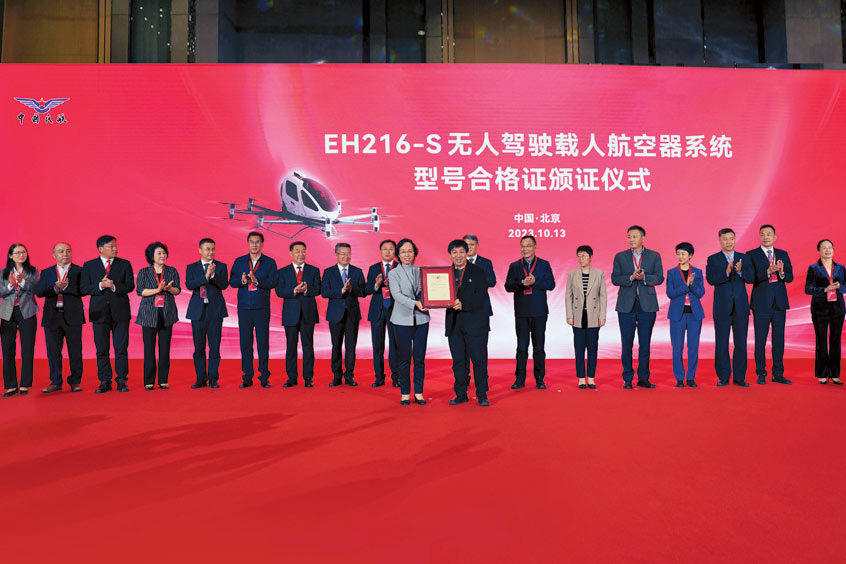Why visit ACE ’25?

EHang has obtained type certification (TC) from the Civil Aviation Administration of China (CAAC) for its EH216-S passenger-carrying unmanned aerial vehicle (UAV) system.
This demonstrates that the EH216-S's model design fully complies with CAAC's safety standards and airworthiness requirements, and that the EH216-S is qualified for conducting passenger-carrying UAV commercial operations. As the world's first TC for unmanned eVTOL, the EH216-S TC not only sets a benchmark for the airworthiness certification of eVTOLs in China and overseas, but also serves as an epoch-making milestone for commercial UAM operations.
Since the CAAC's formal acceptance of EHang's EH216-S TC application in January 2021, the EHang team has worked closely with the administration towards validating and verifying the aircraft's cutting-edge technologies. After more than 1,000 days and nights of persistent effort, they overcame all kinds of difficulties and challenges to successfully complete all type certification objectives, proving that EHang is fully capable of independently designing, developing and manufacturing mature unmanned eVTOL products.
The EH216-S stands as a pioneering technological and product innovation with significant differences from conventional aircraft in key areas including technical architecture, configuration, performance, functionality, operational mode and flight environment. For the EH216-S type certification, CAAC and EHang upheld conventional century-old aviation principles alongside an innovation-centric approach, which involved formulating a specific certification basis and means of compliance tailored to the EH216-S's distinctive technical features.
CAAC assembled experts from local authorities, aviation institutions and research organisations, and formally published the Special Conditions for the EH216-S UAV system in February 2022. Amid a global landscape where eVTOL aviation airworthiness regulations are still evolving, China has formulated a rigorous and scientific regulatory framework of airworthiness certification for the EH216-S. This provides a robust foundation for more efficient and wide-scale airworthiness certification for aircraft of this kind in China and abroad.
During the validation process, the EH216-S underwent extensive laboratory, ground and flight tests at professional aviation laboratories and test sites across multiple locations in China. These tests included but were not limited to main material performance, structural strength, flame resistance, crashworthiness, gas toxicity, environmental conditions of equipment and systems, software simulation, data links, ground control stations, overall system functionality, electromagnetic compatibility, flight performance and flight stability characteristics. The validation process scrutinised components, equipment and the entire aircraft for prefabricated defects, faults and interferences during both laboratory experiments and flight trials. With that, the safety, airworthiness, performance, functionality, usability and reliability of the EH216-S have been thoroughly and rigorously validated through over 500 specific test items, more than 40,000 test flights for adjustments and formal conformity validation tests encompassing 65 major categories and over 450 individual test items. CAAC's experience and expertise in conducting the EH216-S airworthiness certification provide a significant reference for the global aviation industry and will help shape regulations, standards and norms for unmanned eVTOL airworthiness certification worldwide.
EHang chairman and CEO Huazhi Hu says: “I extend my heartfelt gratitude to CAAC, the expert team and all EHang employees for their unwavering dedication. Our self-developed EH216-S passenger-carrying UAV system has finally met high expectations to secure the first TC in the global eVTOL industry, marking a significant chapter in civil aviation history. Embracing the TC as our springboard, we will launch commercial operations of the EH216-S unmanned eVTOLs, prioritising safety above all. This will enable us to steadily progress towards our strategic goal to be a UAM platform operator and commit to our mission to enable safe, autonomous and eco-friendly air mobility accessible to everyone.”